Name of centre: Karnal
Address: CCS HAU Regional Research Station, Uchani Karnal, It is situated 29.685629 N, and the longitude is 76.990547 E.
Staff details: Scientist: 4, STAs: 5, Fieldman: 2
| Sr. No. | Sanctioned post | In position |
| Scientific Staff | ||
| 1. | Maize Breeder | Dr. M.C. Kamboj (Asst. Maize Breeder) |
| 2. | Asstt. Agronomist | Dr. Narender Singh |
| 3. | Asstt. Plant Pathologist | Dr. Prashant Chauhan |
| 4. | Asstt. Entomologist | Due to transfer of Dr. Maha Singh, the post has been advertised and is under the process of recruitment. Now the additional charge has been given to Dr. O.P Choudhary |
| Technical Staff (Senior Technical Assistant) | ||
| 1 | STA (Plant Breeding) | Dr. Kuldeep Jangid |
| 2 | STA (Plant Breeding) | Mr. Puneet Kumar |
| 3 | STA (Agronomy) | Mr. Sanjay Ghangas |
| 4 | STA (Plant Pathology) | Ms. Namita Soni |
| 5 | STA (Entomology) | Mr. Somveer |
| Supporting Staff | ||
| Fieldman | Sh. Ram Dhari | |
| Fieldman | Sh. Vijay Kumar |
Mandate:
- To develop / identify productive inbred lines with multiple resistance against diseases (maydis leaf blight, banded leaf, common rust and sheath blight) and insect pest (Chilo partellus and shoot fly).
- To develop / identify hybrids of normal maize and specialty corn (QPM, Baby corn and sweet corn) suitable for kharif, rabi and spring season for nutritional security and higher returns
- To develop integrated nutrient management and other agronomic practices for newly
- developed hybrids
- To popularize resource conservation technologies in maize systems
- Develop and popularize high yielding, profitable and ecologically sustainable maize-based farming systems
- Mechanization in maize sowing, inter culture and harvesting for reduction in cost of cultivation
- Integrated disease and insect-pest management in maize.
- Post harvest management, value addition and processing in maize.
- To develop module for cultivation of organic maize.
Farm area:
Total farm area at CCS HAU, Regional Research Station, Karnal is 30.8 ha. Out of which approximately 6.5 ha is used in maize research in both the seasons (Kharif and rabi/spring)
Significant achievements (in bullets with photos):
- Genetic improvement in maize:
- Inbred lines developed: Genetic variability in the germplasm is the pre-requisite for successful breeding programme in maize. Genetically diverse material has been used for the development of 464 inbred lines of maize which include 286 lines of normal maize, 53 lines of white maize, 50 lines of quality protein maize (QPM), 24 lines of sweet corn and 26 lines of pop corn. One hundred and fifty inbred lines have been used in combination breeding to develop new hybrids. Thirty inbred lines have been identified as good combiners. Many inbred lines have been identified as N efficient, tolerant against cold, drought, insect-pest and diseases.
B. Hybrids developed
- Single cross hybrids of maize developed and released from CCSHAU, RRS, Karnal
| Hybrids | Year of release | State/ National | Important characters |
 | 2000 | State | Early maturing yellow, dent grain, drought tolerant single cross hybrid for kharif and rabi season, Matures in 83-84 days in kharif season. Average grain yield during kharif is 53-55 q/ha and 60-65 during rabi season. |
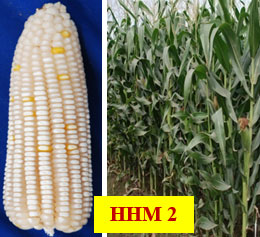 | 2000 | State | First white shining flint grain, medium maturing single cross maize hybrid in the country, released for rabi and kharif season for cultivation in the state. Matures in 88-90 days in kharif season. Average grain yield during kharif 54-55 q/ha and 65-67 q/ha during rabi season. |
 | 2005 | National | First baby corn single cross hybrid in the country, attractive colour of grain and baby corn, released for rabi and kharif, Hybrid matures in 84-86 days in kharif season. Average grain yield during kharif 55-60 q/ha and 67-72q/ha during rabi season. Baby corn average yield is 13-15 q/ha. |
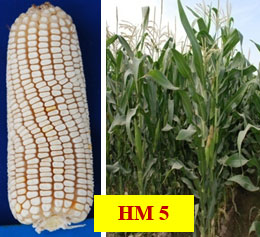 | 2005 | State | Very productive white dent maize hybrid, suitable for intercropping, released for rabi and kharif season. Tolerant to common rust, maydis leaf blight (MLB) and cold. Matures in 88-90 days in kharif season. Average grain yield during kharif 60-65 q/ha and 70-75 q/ha during rabi season. |
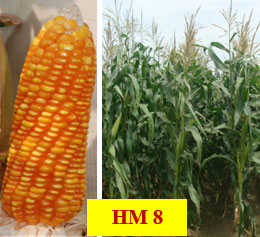 | 2007 | National | Attractive orange and flint grains, single cross normal maize hybrid, released for Andhra Pradesh, Karnataka, Tamil Nadu and Maharashtra, resistant to TLB, SDM and PFSR, tolerant to cold. Matures in 85-86 days in kharif season, grain yield is 55-62 q/ha during kharif and 67-72q/ha during winter. |
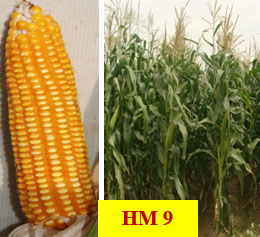 | 2007 | National | Attractive orange and flint grains, single cross maize hybrid, released for Eastern UP, Bihar, WB, Orissa, Jharkhand, Chhatisgarh and MP, resistant to MLB and common rust, tolerant to frost/cold, matures in 85-88 days, grain yield is 57-62 q/ha during kharif and 70-75 q/ha during winter. |
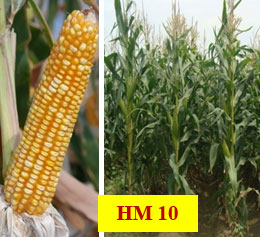 | 2008 | National | Yellow, semi dent grain, single cross normal maize hybrid recommended for winter season, resistant to common rust, MLB, stem borer and cold. Released for all maize growing states of the country. Matures in 88-90 days in kharif season. Average yield during kharif is 57-60 q/ha and 70-75q/ha during rabi season. |
 | 2011 | National | Semi dent, yellow grain single cross normal maize hybrid for kharif season. Responsive to high dose of nutrient, high level of field resistance against MLB and common rust. Matures in 88-90 days in kharif season. Average grain yield during kharif is 57-60 q/ha and 67-70 q/ha during rabi season. |
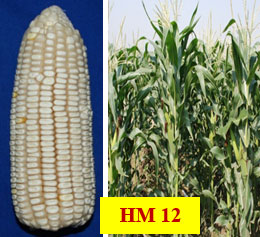 | 2012 | National | First white single cross maize hybrid recommended for Bihar, Jharkhand, Eastern U.P. and Odisha for cultivation in kharif season. It has resistance against MLB and common rust. Matures in 85-87 days in kharif season. Average grain yield during kharif is 55-60 q/ha and 63-68 q/ha during rabi season. |
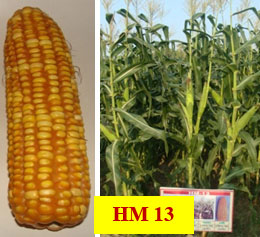 | 2014 | National | High starch yellow grain single cross maize hybrid recommended for Hilly zone (Jammu, Himachal Pradesh, Uttrakhand and north-eastern hills) for cultivation in kharif season. Resistance against MLB, common rust, BLSB and TLB. Matures in 82-85 days in kharif season. Average yield during kharif 55-60 q/ha and 65-68 q/ha during rabi season. |
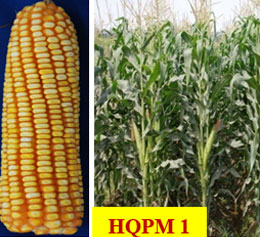 | 2006 | National | First yellow grain, QPM hybrid, released in the state for rabi and kharif season and recommended for release in the country across the zones. Resistant to MLB and common rust. Matures in 88-90 days during kharif season. Grain yield is 57-62q/ha during kharif and 65-70 q/ha during winter. |
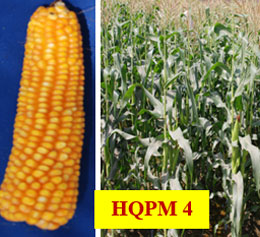 | 2011 | National | QPM single cross hybrid, attractive light orange semi dent grain, released across the country. Matures in 90-93 days during kharif season. Resistant to MLB and tolerant to stem borer. Grain yield is 58-62 q/ha during kharif and 65-72 q/ha during winter season, Green cob yield is 10 % higher over HQPM 1, HQPM 5 & HQPM 7. |
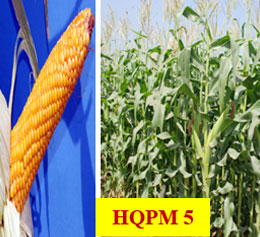 | 2007 | National | QPM single cross hybrid, attractive orange flint grain, released for cultivation across the country. Resistant to MLB, common rust, BLSB and PFSR. Matures in 88-91 days, grain yield is 60-62 q/ha during kharif and 67-72 q/ha during winter season. |
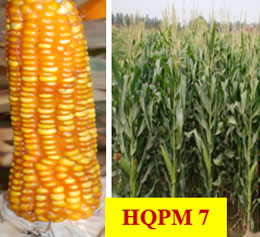 | 2008 | National | QPM single cross hybrid, released for Andhra Pradesh, Karnataka, Tamil Nadu and Maharashtra. The grain is light orange. The hybrid is resistant to MLB and stem borer. Matures in 88-91 days, grain yield is 60-64 q/ha during kharif and 67-72 q/ha during winter season. |
 | 2011 | National | First public sector bred single cross sweet corn hybrid, released for cultivation in hilly zone (Jammu, Himachal Pradesh and Uttrakhand) during kharif season, average yield of green cobs 120 q/ha, ready to harvest in 80-82 days, resistant to MLB and common rust. |
Note: Days to maturity and grain yield data mentioned above is under Haryana condition
Nine of the maize hybrids developed and released from Karnal centre viz. HM 4, HM 8, HM 9, HM 10, HM 11, HQPM 1, HQPM 4, HQPM 5 and HQPM 7 have been used as national checks in different AICRP trials.
b. Inter-institutional hybrids developed: Karnal centre has shared maximum inbred lines to different AICRP centers. Different AICRP centers are using inbred lines developed by this centre for the development of inter-institutional maize hybrids. A large number of such hybrids have been tested in co-ordinated trials and 12 inter-institutional hybrids have been released and notified for cultivation in different part of the country. The detail of these hybrids is as follows:
| Name of hybrid | Year of release | Pedigree | Recommended area | Collaborating centre | Important characters | |
| 1 | Malviya Hybrid Makka-2 | 2007 | HUZM 185 x HKI 1105 | Zone III | BHU, Varanasi | Average grain yield is 54 q/ha. Yellow semi flint grain, MLB resistant. |
| 2 | Maha Rana Partap QPM 1 | 2013 | HKI 193-1 x DMR QPM 106 | Zone V | Maha Rana Partap University of Agriculture and Technology, Udaipur | Average grain yield is 54 q/ha. Yellow semi flint grain, MLB resistant. |
| 3 | Palam Sankar Makka I (EHL 162508) | 2015 | HKI 1040-7 x BAJ 169-09-64 | Zone I | CSKHPKV, HAREC, Bajaura | Yellow maize with average grain yield is 60 q/ha. |
| 4 | Pusa HM 4 | 2018 | EDV (QPM version of HM 4) | Zone II | ICAR-IARI New Delhi | QPM version of HM 4 |
| 5 | Pusa HM 8 | 2018 | EDV (QPM version of HM 8) | Zone IV | ICAR-IARI New Delhi | QPM version of HM 8 |
| 6 | Pusa HM 9 | 2018 | EDV (QPM version of HM 9) | Zone III | ICAR-IARI New Delhi | QPM version of HM 9 |
| 7 | DMRH 1308 | 2018 | SML 16 x HKI 163 | Zone V | ICAR-IIMR, Ludhiana | Average grain yield is 90 q/ha. |
| 8 | IMHB 1539 | 2019 | HKI 1105 x IML 127-1 | Zone I | ICAR-IIMR, Ludhiana | It is a baby corn hybrid The average baby corn yield of this hybrid is 1250 kg/ha. |
| 9 | DMRH 1305 | 2019 | B-373 x HKI 1105 | Zone 1 | ICAR-IIMR, Ludhiana | Early maturing normal maize hybrid. Average grain yield is 65 q/ha. |
| 10 | IMH QPM 1530 | 2019 | IML 343 x HKI 163 | Zone 1 | ICAR-IIMR, Ludhiana | It is a QPM hybrid with grain yield 85 to 90 q/ha |
| 11 | Pusa HQPM-5 Improved | 2019 | HQPM 5 fortified with provitamin A | Across the country | ICAR-IARI New Delhi | QPM hybrid fortified with Pro-vitamin |
| 12 | Pusa HQPM-7 Improved | 2019 | HQPM 7 fortified with provitamin A | Zone IV of the country | ICAR-IARI New Delhi | QPM hybrid fortified with Pro-vitamin |
2. Registration of genetic material
a. Registration of elite genetic material (INGR & IC No. separately).
The elite inbred lines have been registered with NBPGR. The detail is as follows:
| S. No. | Name of inbred lines | Year | Registration No. | INGR No. | Remarks |
| 1 | HKI-209 | 2003 | IC405277 | 3055 | Protogyny |
| 2 | HKI-335 | 2003 | IC405279 | 3056 | Early maturity and stay green |
| 3 | HKI-139 | 2004 | IC405276 | 4065 | Early, dark erect green MLB resistance, orange grain colour and GCA |
| 4 | HKI-323-8 | 2004 | IC405278 | 4066 | Medium MLB resistant, orange grain colour and GCA |
| 5 | HKI-1025 | 2004 | IC405280 | 4067 | Early, Dark erect green leaf, cold tolerant and MLB resistance |
| 6 | HKI-1040-7 | 2004 | IC45281 | 4068 | Dark green leaves, good pollen shedder, and MLB and rust resistance |
| 7 | HKI-1105 | 2004 | IC405282 | 4069 | Broad erect leaves bold seeded and GCA |
| 8 | HKI-1348-2 | 2004 | IC405283 | 4070 | White grained, good pollen shedder, MLB and rust resistance and GCA |
| 9 | HKI-1352-58-9 | 2004 | IC405284 | 4071 | Bold white grained good pollen shedder, MLB and rust resistance and GCA |
| 10 | HKI-1354 | 2004 | IC405285 | 4072 | Long cob, white grained, good pollen shedder, MLB and rust resistance and GCA |
| 11 | HKI-295 | 2004 | IC408327 | 4073 | Medium maturity good pollen shedder MLB and rust resistant and GCA |
| 12 | HKI-586 | 2004 | IC408328 | 4074 | Early, dark green erect leaves, MLB resistance and GCA |
| 13 | HKI -1344 | 2004 | IC408330 | 4075 | Medium, bold white grained, MLB resistance and GCA |
| 14 | HKI-1332 | 2004 | IC408327 | 4120 | Medium maturity, dark green erect leaves and good GCA |
| 15 | HKI-288-2 | 2008 | IC563956 | 8071 | Late maturing disease resistant female parent for single cross hybrid |
| 16 | HKI-1126 | 2008 | IC563958 | 8072 | Late maturing, bold seeded, resistant to MLB seed parent with economic seed production |
| 17 | HKI-1040-4 | 2008 | IC563959 | 8073 | Good tassel trait, attractive red grain color, resistance MLB & rust, good for early maturing single cross hybrid |
| 18 | HKI-1015 WG-8 | 2008 | IC563961 | 8074 | Source of less leaf trait & good general combining ability |
| 19 | HKI-1347-4LT(1+2+3) | 2008 | IC563964 | 8075 | Late maturing white seeded productive inbred line |
| 20 | HKI-164D-4(0) | 2008 | IC563965 | 8076 | Productive Quality Protein Maize (QPM) inbred line with high tryptophan (0.86%) and late maturity |
| 21 | HKI-164-7-6 | 2008 | IC563966 | 8077 | Semi-dent inbred with PQM background, high tryptophan content (0.94%) and good combining ability |
| 22 | HKI-47 | 2009 | IC563953 | 9057 | Good pollen shedder, attractive grain color, resistant to common rust |
| 23 | HKI-287L | 2009 | IC563954 | 9058 | Late maturing with dark green leaves with orange grain |
| 24 | HKI-327 T | 2009 | IC563955 | 9059 | Tall, dark green broad leaves, resistant to MLB and rust and late maturing |
| 25 | HKI-326 | 2009 | IC563957 | 9060 | Very long cobs, with attractive orange grain, good combiner with late maturity |
| 26 | HKI-1040-5 | 2009 | IC563960 | 9061 | Dark green leaves, orange grain, good combiner, medium maturing |
| 27 | HKI-1341 | 2009 | IC563962 | 9062 | Dark green leaves, white bold grains, resistance to common rust, late maturing |
| 28 | HKI-1342 | 2009 | IC563963 | 9063 | White shining grains, resistant to rust and MLB, late maturing |
| 29 | HKI-170 (1+2) | 2009 | IC563967 | 9064 | Yellow grains QPM, late maturing and good combiner |
| 30 | HKI 322 | 2010 | IC0584587 | 10081 | Medium duration white, flint grain productivity, strong plant and dark green leaves |
| 31 | HKI-139-2 | 2010 | IC0584588 | 10082 | Medium duration white flint grain good combining ability |
| 32 | HKI 5072-2-BT | 2010 | IC0584589 | 10083 | High tryptophan (0.66%), medium duration, yellow, flint, attractive grain colour and dark green leaves |
| 33 | HKI PC-4B | 2010 | IC0584599 | 10093 | High popping, medium duration and good pollinator with droopy leaves |
| 34 | HKI PCBT-3 | 2010 | IC0584600 | 10094 | High popping, early, good pollinator and dark green leaves |
| 35 | HKI-6 | 2010 | IC0584601 | 10095 | High oil content(6%) and yellow flint grain |
| 36 | HKI-1(T) | 2010 | IC0584602 | 10096 | High oil content (6.31%) and yellow flint grain |
- Hybrids registered under PPV &FRA: Maize hybrids HHM 1, HHM 2, HM 4, HM 5, HM 8, HM 9, HM 10, HM 11, HM 12, HM 13 HQPM 1, HQPM 4, HQPM 5 and HQPM 7 have been registered under PPV & FRA.
State recommendations:
Agronomic recommendations
The CCS HAU, Regional Research Station, Karnal has given complete production technology for maize cultivation in all the three seasons i.e. kharif (monsoon), rabi (winter) and spring seasons in Haryana.
To achieve higher yield at farmer’s field assured irrigation facilities are required.
The optimum time of sowing, spacing and seed rate in different seasons is as follow by table:
| Season | Planting time | Spacing | Seed rate |
| Kharif | Last week of June to 20 th of July | 75 x 20 cm | 18 -20 kg/ha |
| Rabi | Last week of 20th of November | 75 x 20 cm | 20 -22 kg/ha |
| Spring | Last week of January to 15th of February | 60 x 20 cm | 20 -22 kg/ha |
Method of sowing
Sowing of maize on southern sides of east west ridges at depth of 5- 6 cm has been found to give better germination and growth.
Ridge and furrow sowing of maize
The traditional practice of growing maize crop has several limitations such as inconvenient input management when sown by broadcasting, improper plant geometry and uneven plant stand resulting in insufficient utilization of space and plant competition leading to low productivity and input use efficiency. Ridge and furrow method of sowing can help to maintain proper plant competition and better input management leading to higher productivity and input use efficiency. It conserves soil moisture during prolonged dry spell in water scarcity areas for longer availability of moisture to sustain life and act as drainage channel in high rainfall/water logged area and provide better microclimate for plant growth and root development. However, pre-requisite for ridge and furrow are:
- Laser leveling of the field.
- Prepare beds in East-West direction.
- Sowing on the sides of the ridges.
Fertilizers requirement and schedule
Application of nutrients @ 180-60-60-25 kg/ ha (N-P2O5-K2O-ZnSo4) have been found optimum for winter maize and spring season, whereas nutrients @ 150-60-60-25 kg/ ha (N-P2O5-K2O-ZnSo4) gave higher yield during kharif season. Fertilizers schedule i.e. 1/3rd N + full P, K & Zn at sowing, 1/3rd N at knee high stage, 1/3rd at tasseling stage gives higher productivity and nutrient use efficiency.
Weed management
Weeds compete with crop for nutrient and cause yield loss up to 30–40% depending upon season of planting and crop rotation followed. Atrazine applied as preemergence (2-3 days after sowing) @ 1.0-1.50 kg/ha followed by one hoeing at 25-30 DAS was found to give satisfactory control of all type of weeds in kharif maize. Herbicide tembotrione 34.4% SC w/w (Laudis 42% SC w/v) @ 287.5 ml/acres + surfactant @ 1000 ml/ha in a spray volume of 200 liter water at 2-4 leaf stage of weeds (10-15 days after sowing) for control of complex weed flora in maize has been recommended.
Irrigation management
Irrigation should be applied when required depending upon rains and moisture holding capacity of the soil. Water should not overflow on the ridges. Irrigation applied in furrows up to 2/3rd height of the ridges/bed helps in improving water use efficiency. Inbreds responded to light and frequent irrigations. Irrigation schedule for different season are given in following table:
| Kharif season | Rabi season | Spring season |
| Young seedling | Young seedling | Young seedling |
| 20-25 days interval | Knee high stage | Knee high stage |
| Additional 4-5 irrigations are required during severe winter period to protect the crop from cold/frost damage | Additional 2-3 irrigations are required during after knee height stage for proper growth | |
| Tasseling stage | Tasseling stage | Tasseling stage |
| Grain filling stage | Grain filling stage | Grain filling stage |
| Dough stage | Dough stage | Dough stage |
Earthing up
Earthing up after second application of fertilizer has been found effective to avoid lodging of crop.
Disease management – State-wise we may give predominant diseases and their control measures
Major diseases of maize in Haryana and their management
1.Maydis Leaf Blight
The disease is very prevalent under hot-humid conditions. The symptoms start from lower leaves and progress to upper leaves of maize plant. The disease can be recognized by the presence of diamond shaped lesions which are in brown in colour. The lesions may coalesce producing a complete burning of large areas of the leaves. In severe cases the disease affects the cob also. The damage to the crop become more critical when infection occurs prior to silking stage.

2. Banded Leaf and Sheath Blight
The infected plant shows the presence of irregular patches on the leaves, leaf sheaths and cobs. The blotches on plants with greyish-green or straw coloured centres and with distinct brown borders are main symptoms. Banded Leaf and Sheath Blight normally starts at the base of the plants and progresses its infections towards the upward directions. In severe cases the cobs are ultimately affected which may cause significant yield losses. Humid conditions and irrigated fields are highly favourable for the disease incidence and progress.

Integrated Disease Management
- Treat the seed with 4gm Thiram per kg of seed.
- At knee high stage of crop spray Mancozeb (Indofil M-45) 600 gm in 200 liter of water and repeat the spray at 10-15 days interval if required.
- Maintain proper plant population and avoid water logging conditions in the field.
- At crop stage 5-7 weeks, remove the infected plants and burry them in the soil away from the crop.
3.Common Rust
The disease symptom includes the presence of small circular brown rusty pustules or blisters on the upper and lower surfaces of the leaf. Susceptible materials turned prematurely died, leaves show burning look and yield is severely affected. Rust pathogen infects leaf sheath and corn husk also.

Disease Management
Mix 400-600g Mancozeb (Dithane M-45) in 200-250 litre water and spray 2-3 times can prevent the rust infection.
Bacterial Stalk Rot
Primary symptoms generally appear in mid-season when plant suddenly falls over. One to several internodes above soil level may be affected. The infected tissues are Tan to dark brown, water soaked slimy lesions are macerated, easily breakable and emit foul odour. Affected plant may remain green for several days.

Disease Management
Apply 150 gm Captan and 33 gm stable bleaching powder in 100 litre of water near root zone
Major insect pests of maize in Haryana and their management
Stem Borer (Chilo partellus): It is a serious pest in Kharif/rainy season. Under severe infestation conditions field having large number of dead hearts and sometimes resowing of crop becomes necessary. The symptoms of plant damage caused by this pest have been shown as below:
Control: Spray the crop with any one of the following insecticide per acre after 10 days and 20 days of germination in the central whorl of plant.
Spray: 250 ml Monocrotophos 36SL or 200 ml Dichlorvas 76 EC or 500 ml Quinalphos 25 EC in 250 litre water.
IPM strategy:
- Use resistant cultivars.
- Use of Trichogramma spp. and Apantalis spp. for parasitization of eggs and larvae of Chilo partellus, respectively. Release of 8cards / ha after 7, 14 and 21 days of germination of crop reduces the larval population in the field.
Shoot fly (spring season): Shoot fly is a very serious pest of spring maize if crop is sown after 15th February. It causes dead hearts in early stage of the plants. If the incidence is serious then resowing of the crop becomes imminent.
Control
- Seed treatment with Imidacloprid 600 FS or Fipronil 5SC @ 7ml/ kg is found effective to control shoot fly.
- Sowing of maize before 15th February during spring season .
Termite: Termite incidence is observed in patches in maize.
Control: Seed treatment with Thiamethoxan @ 6 g / kg seed is found effective up to 3 months of sowing.

Dead heart 
Leaf holes damage
Symptoms caused by Chilo partellus

Chilo partellus larva 
Larva Parasitized by Apantalis spp. 
Aphid incidence 
Lady bird beetle predating on aphid 
Mechanism of resistance 
Egg of shoot fly
Other significant contributions
- Technology commercialized: The University has signed MOUs with twenty seed companies from different parts of the country for commercialization of maize hybrids developed by Maize section, CCS HAU Regional Research Station, Karnal.
- International training organized: Three international trainings on maize cultivation have been organized for scientists and extension officers of Kingdom of Swaziland country.
| Sr. No. | Period | Country |
| 1 | December 1-6, 2014 | Mozambique |
| 2 | September 21-28, 2015 | Swaziland |
| 3 | March 7-16, 2016 | Swaziland |
Award and honour:
- Best AICRP Maize Centre Award 2012: CCS HAU RRS, Karnal Centre was awarded “Best AICRP Maize Centre Award 2012” by Directorate of Maize Research, New Delhi in recognition of the research contribution for strengthening maize research in the country in 55th AICRP Annual Maize Workshop, held at CCS HAU Hisar. April 20-22, 2012.
- Mahindra Agri Award 2015: CCS Haryana Agricultural University has received Mahindra Agri Award 2015.This honour was awarded due to three important crop varieties developed by the University. Out of these, two hybrids (HM 12 & HM 13) have been developed by the Maize Section, CCS HAU RRS Karnal.
- Best outreach station award: CCS HAU Regional Research Station received best outreach station award for outstanding contribution in research and extension. The maize section is one the major components of the station.
Success stories:
Baby corn hybrid HM 4: Baby corn hybrid HM 4 can be grown throughout the year, which can help in generating employment to the farmer, rural women and youth as labour force needed for cultivation, processing and marketing.
With the development of baby corn hybrid HM 4, baby corn cultivation became popular in village Aterna, district Sonepat in Haryana. Now whole of the village is cultivating baby corn. They established a co-operative packaging unit of baby corn in the village itself under the leaderhip of the farmer Sh. Kanwal Singh Chouhan who is selling baby corn worth Rs. 10 crores every year and baby corn has become source of livelihood in that area. Sh. Kanwal Singh Chouhan has received Padam Shri Award recently for this social upliftment of the society.
Now there are four baby corn industries in Haryana viz. Pratibha Foods, Village Aterna, Sonepat; Shimla Farm, Village Aterna, Sonepat; Gulab Fruit and vegetable Growers & Marketing Co-operative Society Ltd., Food Park, HSIIDC Rai, Sonepat and Integrated Unit for Mushroom Development, Kundli, Sonepat in the state, each of these industries are processing approximately 150 -200 tonnes of baby corn every year.
QPM hybrid HQPM 1:
HQPM -1 being a quality protein maize hybrid is nutritionally superior and its biological value is double than the normal maize. It is best option as food, feed and silage. West Bengal Govt. Agricultural officers took training at CCS HAU RRS Karnal for seed production and learned the hybrid seed production technology of HQPM 1. State started growing HQPM-1, a high yielding quality protein maize hybrid developed from this centre and now more than 45000 hectares area is under this hybrid alone in west Bengal. This hybrid helped in increasing the productivity of maize in the state. The use of HQPM 1 as poultry feed helped in reducing the cost of poultry rearing in the state. Ultimately the productivity of the poultry has also improved in West Bengal. Dr. Sain Dass, developer of this hybrid and former Director, IIMR has been honoured by Govt. of West Bengal as Life Time Achievement Award during 2018. This hybrid is popular in many states of the country viz. Jammu and Kashmir, Haryana, Gujarat, Rajasthan etc. This hybrid has been declared as land mark cultivar of maize.
Information on Patents: No patent has been granted to the station but the information regarding inbred lines registered with NBPGR and hybrids registered with PPVFRA has been provided in the documents.

